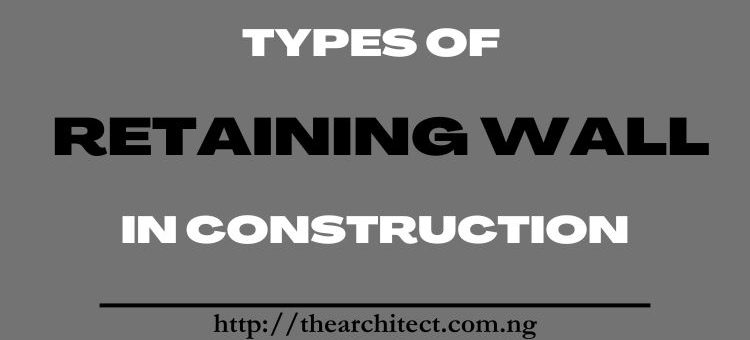
Types of Retaining Walls and Material Details in Construction
- Posted by Ikenna N.
- On July 11, 2025
- 1 Comments
The various types of retaining walls are built for the sole purpose of withstanding lateral pressure or holding materials back. Earth filling, liquid pressure, sand, and other granular materials are some of the factors that generate lateral pressure on retaining walls.
Retaining wall structures come in many forms and serve a variety of functions. Common examples of retaining walls in everyday life are basement walls, swimming pool walls, landscape walls, land reclamation walls, etc. TheArchitect has researched this topic to give you a detailed review. Read further down.
Table of Contents
What is a Retaining Wall?
A retaining wall is a structure designed and constructed to hold soil behind it. It is typically used to prevent soil erosion and to create a level area for construction purposes. Retaining walls can be made of a variety of materials, including concrete blocks, natural stone, brick, and timber.
They are often used in landscaping and garden design to create terraced slopes or to provide a decorative element to the landscape. Retaining walls can also be used in civil engineering projects, such as road construction or flood control measures.
Importance of Retaining Walls
Retaining walls are an essential part of civil engineering and construction projects. They are vertical or sloping structures designed to hold back soil or other materials and prevent them from sliding or collapsing. Retaining walls are used in a variety of settings, including highways, bridges, waterfronts, and residential properties.
The importance of retaining walls is detailed as follows:
Soil Stabilization:
Retaining walls are used to stabilize slopes and prevent soil erosion, which can cause damage to nearby structures and pose a threat to people’s safety.
They provide a stable base for construction projects, such as roads, buildings, and bridges. By retaining soil, retaining walls help prevent landslides and soil erosion.
Landscaping and Aesthetics:
Retaining walls can be designed to create terraced landscapes, providing more usable areas for gardens, parking, and other purposes.
They can also enhance the visual appeal of a property by adding texture and depth to the landscape.
Flood Control:
Retaining walls can be designed to incorporate drainage systems that prevent water from building up behind the wall.
They can be used to control and direct the flow of water, preventing flooding and reducing the risk of damage to buildings and other structures.
Structural Support:
Retaining walls can also provide structural support for buildings and other structures that are built on slopes or uneven terrain.
They can be a cost-effective solution for managing sloping terrain. They require less excavation and grading than other methods, such as terracing or grading.
Types of Retaining Walls
Retaining walls can be classified into several types based on their design, materials used, and construction methods. Here are the most common types of retaining walls and their applicability:
Gravity Retaining Walls
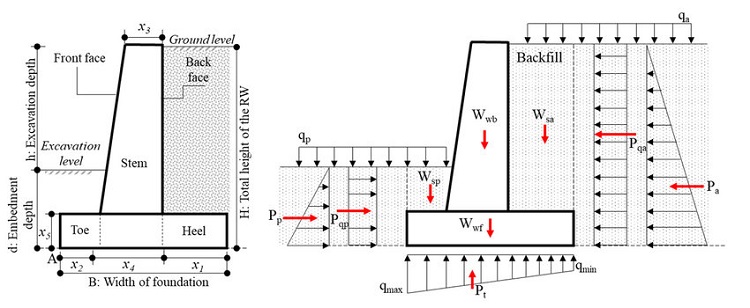
Gravity retaining walls rely on their own weight to resist the pressure of soil and water. They are made of heavy materials such as concrete, stone, or masonry.
These walls are suitable for low to medium-height applications where the soil is stable and the loads are not too heavy.
Cantilever Retaining Walls
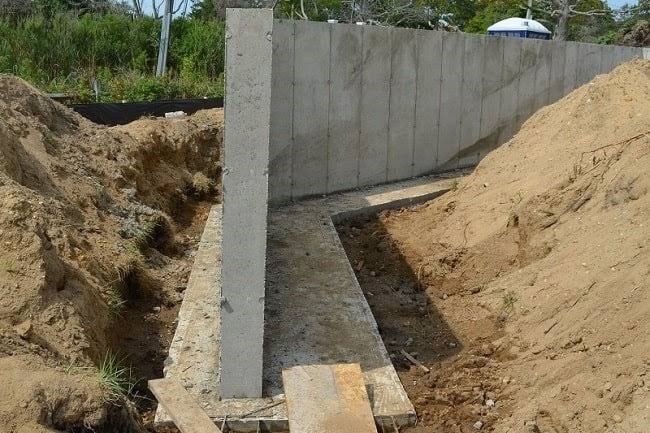
Source: Structures center
Cantilever retaining walls are made of reinforced concrete and have a thin stem and a base slab. They are designed to resist the lateral pressure of soil by transferring the weight of the soil to the base slab. They are suitable for medium to high-height applications. To increase their strength against heavy loads, cantilevered walls are occasionally buttressed on the front or incorporate a counterfort on the back.
Short-wing walls that are at an angle to the wall’s primary trend are known as buttresses. These walls need strong concrete footings that are below the seasonal frost line. Compared to a conventional gravity wall, this kind of wall needs a lot less material.
Sheet Pile Retaining Walls
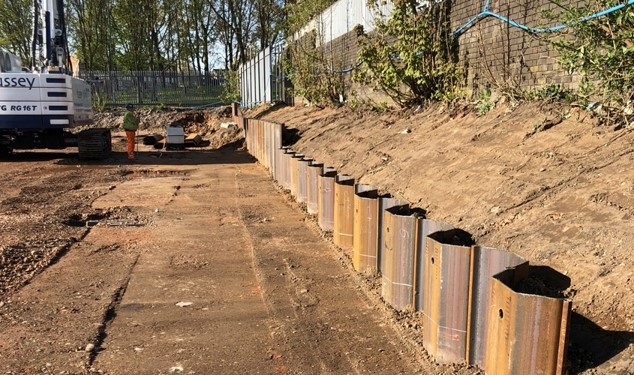
Source: Fusseypiling
Sheet pile retaining walls are made of steel, vinyl, or wood planks that are driven into the ground. They are suitable for temporary applications or where the soil is soft and waterlogged. Piling is an excavation support method that uses sheet sections with interlocking edges to retain dirt.
The pile is pushed into a slope or excavation to support the soft soils collapse from higher ground to lower ground, acting as a temporary certificate wall. It offers excellent resistance to driving pressures. With minimal protection, sheet piles can be reused repeatedly and have a long service life above or below water. Joints are easier to adjust for pile length by attaching or bolting, and they are less likely to deform while driving.
Anchored Retaining Walls
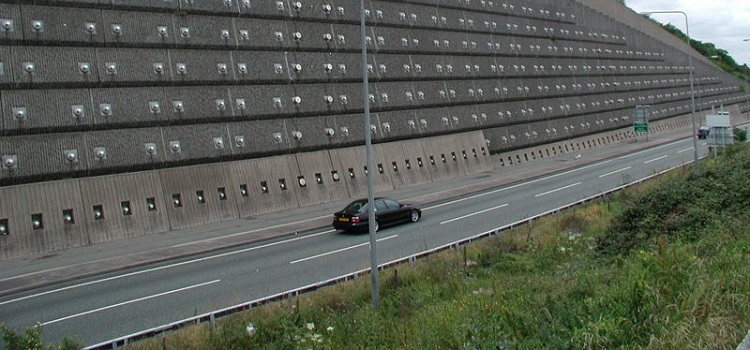
Source: Constrofacilitator
Anchored retaining walls are similar to cantilever walls but are reinforced with cables or other tensioning devices. The cables are anchored to the soil or rock behind the wall to resist the lateral pressure of the soil. These walls are suitable for high-height applications and where the soil is unstable.
Gabion Retaining Walls
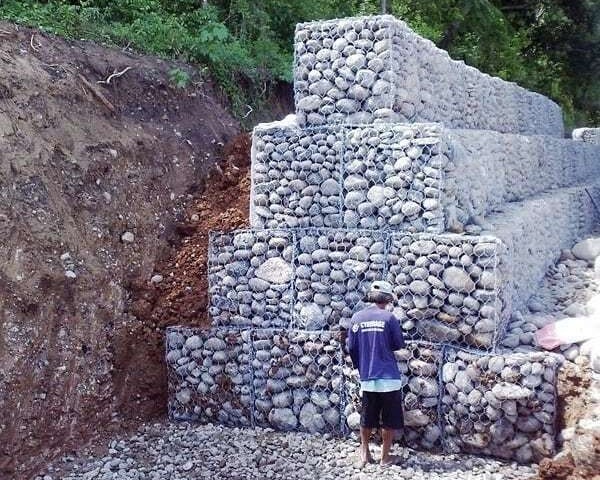
Source: Structville
Gabion retaining walls are made of wire baskets filled with rocks or other materials. They are suitable for low to medium-height applications and where the soil is stable.
Reinforced Soil Retaining Walls
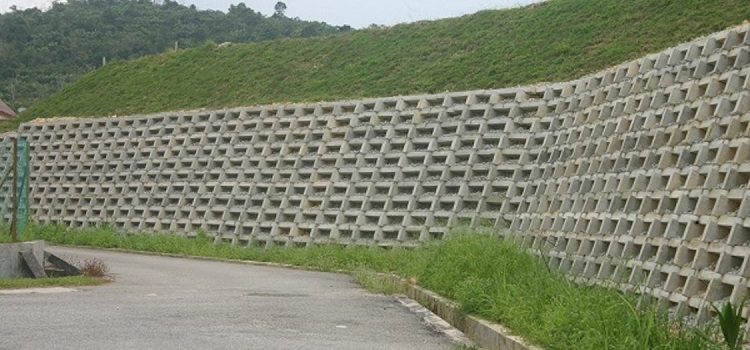
Reinforced soil retaining walls are made of soil reinforced with geotextiles or steel strips. They are suitable for low to medium-height applications and where the soil is stable.
Conclusion
Retaining walls are primarily used to stop soil erosion, make beds out of steep terrain, and provide aesthetically pleasing or practical landscape features. They could be standalone structures or a component of a larger construction project, such as a building.
The choice of retaining wall type depends on several factors, including the height of the wall, soil conditions, water pressure, and design requirements. It is best to consult with a structural engineer or a retaining wall expert to determine which type of retaining wall will work best for your specific application.





1 Comment